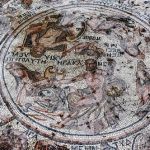 Weird Stuff
Weird Stuff  Weird Stuff
Weird Stuff  Animals
Animals 10 Inspiring Tales of Horses Being Human
 Mysteries
Mysteries Top 10 Haunting Facts About the Ghost Ship MV Alta
 History
History 10 Surprising Stories About the Texas Rangers
 Humans
Humans 10 Philosophers Who Were Driven Mad by Their Own Theories
 Miscellaneous
Miscellaneous 10 Video-Game-Worthy Weapons and Armors from History
 Weird Stuff
Weird Stuff 10 Psychics Who Accurately Predicted Wartime Events
 The Arts
The Arts 10 Pieces of Art Inspired by a Broken Heart
 Health
Health 10 Science Fiction-Sounding New Medical Treatments
 History
History 10 Surprising Facts About the Father of Submarine Warfare
 Weird Stuff
Weird Stuff 10 Times Real Laws Were Based on Bizarre Hypotheticals
 Animals
Animals 10 Inspiring Tales of Horses Being Human
 Mysteries
Mysteries Top 10 Haunting Facts About the Ghost Ship MV Alta
Who's Behind Listverse?

Jamie Frater
Head Editor
Jamie founded Listverse due to an insatiable desire to share fascinating, obscure, and bizarre facts. He has been a guest speaker on numerous national radio and television stations and is a five time published author.
More About Us History
History 10 Surprising Stories About the Texas Rangers
 Humans
Humans 10 Philosophers Who Were Driven Mad by Their Own Theories
 Miscellaneous
Miscellaneous 10 Video-Game-Worthy Weapons and Armors from History
 Weird Stuff
Weird Stuff 10 Psychics Who Accurately Predicted Wartime Events
 The Arts
The Arts 10 Pieces of Art Inspired by a Broken Heart
 Health
Health 10 Science Fiction-Sounding New Medical Treatments
 History
History 10 Surprising Facts About the Father of Submarine Warfare
10 Times Tree Rings Revealed Historical Gems
The field of dendrochronology studies tree rings. The latter can convey accurate information about the age of trees, climate trends, and past events going back thousands of years. Although, that’s not all they can tell us.
Incredibly, tree rings can reveal bizarre and unexpected moments as well. From a toxic Nazi cloud to an ancient earthquake that’s bad news for Seattle, here are ten fascinating things written in the trees.
Related: 10 Futuristic Technologies That Could Change the World
10 The Age of Violins
Old violins are valued for their craftsmanship, history, and potential links to famous instrument makers like Antonio Stradivari. Violins with a confirmed age can command a good price, and to determine when an instrument was made, experts look at the opacity of the wood, what type of varnish was used, and the wear and tear on the violin’s body.
However, music lovers can also turn to dendrochronology to assess the origins of their favorite violin. This method involves looking at the tree rings on the instrument’s body.
Tree rings offer the first scientific way to tell the age of stringed instruments, and the process involves studying the properties of the rings to pinpoint where the trees came from and when the wood was used. By comparing this information to the tree ring data of other trees and instruments with established times and places, a violin’s heritage can be better understood.[1]
9 Thera’s Explosion Date
A long time ago, the Greek island of Santorini experienced a volcanic eruption. This was no small puff of smoke. When the volcano Thera blew up, it was one of the biggest eruptions in history. To put the damage into perspective, a nearby settlement was buried under 130 feet (40 m) of rock and ash.
Researchers struggled to settle the date of the disaster, mainly because the two main methods used to provide more information gave conflicting time brackets. Radiocarbon dating placed the eruption between 1650 and 1600 BC, while archaeological evidence pointed to between 1570 and 1500 BC.
In 2018, scientists narrowed down the date thanks to tree rings. The study looked at 285 trees that lived between 1700 and 1500 BC. The volcano’s fallout interfered with their growth rings in such a way that it suggested that Thera blew its top roughly 3,600 years ago between 1600 and 1525 BC.[2]
8 The Identity of a Shipwreck
In 2004, remnants of a ship were discovered near Puerto Madryn, Argentina. Nearby artifacts suggested the planks belonged to a vessel listed as missing for nearly 150 years. In 1858, the whaling vessel, the Dolphin, left Rhode Island and vanished. While the items hinted that the Argentinian wreck was indeed the lost ship, nothing could concretely prove this was the Dolphin.
In 2019, researchers used dendrochronology to determine the origins and age of the wood. If the timber’s particulars and the whaler’s construction date lined up, it could add more evidence that the wreck was the Dolphin.
Several cross-sections were compared to a database of 30,000 trees going back over 2,000 years. It revealed that the shipwreck’s planks were white oak and yellow pine. The latter grew in Alabama, northern Florida, or Georgia, all areas that provided timber to builders in the 19th century. Even more encouragingly, the rings showed that the trees were felled in 1849, just a year shy of the Dolphin’s construction in 1850.[3]
7 The Huns Were Hungry
Atilla the Hun is not remembered with fondness. The Romans described him as a gold digger who demanded precious metals and land from the Roman Empire. The fact that he kept raiding the eastern Roman provinces didn’t help his image, either.
According to tree ring records, the Huns might not have been purely motivated by greed. Instead, it’s possible that Atilla was also desperately trying to keep his people alive.
The 2022 study examined oak trees that once grew in Bavaria and the Czech Republic. They revealed that the Huns’ home ground, the Great Hungarian Plain, was hit by extremely dry summers in the early fifth century. This caused a severe drought that could’ve played a role in Atilla’s decision to invade Roman settlements.
While classical historians described him as a monster (and let’s be honest; he was a violent invader), the tree ring study suggests that sheer hunger and a fight to survive also drove Atilla to forcefully take precious resources like gold, livestock, and fertile grazing lands.[4]
6 Ancient Trees Ripped Themselves Apart
Tree fossils belonging to the group cladoxylopsids have been unearthed in many countries. Most were in bad shape, and researchers couldn’t properly look at the anatomy of these trees until well-preserved samples were discovered in China. Very quickly, though, they discovered a surprise. There were no tree rings. Not in the conventional sense, anyway.
Trees alive today form a ring for every year of growth. But the cladoxylopsids trunks, which lived 374 million years ago, relied on a unique process that was far more complicated and brutal.
Inside the trees, a woody web of strands (called xylem) stretched throughout the trunk. Each strand had its own rings, like a collection of mini trees. When new growth occurred, soft tissues pushed the strands to their breaking point. In some cases, the trees tore themselves apart as they expanded. Incredibly, any shredded xylem always repaired themselves.
It remains a mystery why these trees evolved to grow by tearing their own skeletons apart when trees today have a much simpler growth pattern.[5]
5 Adams Transitional Geomagnetic Event
The Adams Transitional Geomagnetic Event describes a time when Earth’s magnetic field flipped about 42,000 years ago. The consequences were wild and the story is written in ancient tree rings.
The 2021 study examined the fossils of New Zealand kauri trees. More specifically, the scientists analyzed the radiocarbon preserved in the rings. It not only revealed the date of the Adams event but also that Earth’s magnetic field collapsed and left the planet without a shield against cosmic radiation.
It likely led to years of upheaval, which is corroborated by historical events that occurred during this time, like the mass extinction of Australia’s megafauna. The Adams Event also coincides with some of the oldest cave art, the use of caves, and more red ochre being applied as sunscreen.
This happened in different parts of the ancient world with communities that lacked contact with each other. This global penchant for suddenly living indoors suggested that people were hiding from a sun that had become too intense.[6]
4 A Toxic Nazi Cloud
During WWII, the German battleship Tirpitz was the largest ship in Germany’s navy. For much of the war, it stalked the Norwegian coast to deter an Allied invasion. The Tirpitz knew that every Allied ship in the area was looking for it, so the crew devised a plan to keep the vessel concealed. They released a cloud of fake mist to hide it from view.
Was this “mist” just harmless water vapor? Nope. It was chlorosulfuric acid. The toxic cloud hid the ship until 1944, when RAF Lancasters destroyed it. The effects of the smokescreen on the Norwegian fjords lasted longer and were extremely damaging. In 2018, a dendrochronologist stumbled upon the terrible aftermath when she examined the tree rings of pines at a place called Kåfjord—or lack of them.
Starting in the year 1945, some of the trees showed no growth rings. One tree didn’t grow for nine years, and it took three decades to return to a normal growth pattern. Other trees had growth rings, but they were barely visible. Frighteningly, the damage stretched for several miles.[7]
3 A Monster Earthquake (or Two)
In the Pacific Northwest, building codes do not require structural designs to withstand powerful earthquakes. The reason? Researchers couldn’t prove that the region had a history of deadly quakes despite knowing that some probably occurred between 780 and 1070.
Needing a reliable way to narrow down the dates and magnitudes, a recent study turned to dendrochronology. In ancient times, local earthquakes triggered massive tsunamis, which drowned trees. So knowing when the trees died would give scientists more precise information.
They examined tree rings from six sites around Puget Sound in Washington State and discovered something worrying. The ancient trees, which died between 923 and 924, were felled by a massive earthquake. Possibly even two in close succession.
The magnitude was around 7.5, and the event occurred near modern-day Seattle. The strength is concerning. An older study has predicted that if a weaker earthquake, like a 6.7-magnitude event, occurred along the Seattle fault today, it could lead to 1,600 deaths, destroy 10,000 buildings, and cause $50 billion in damages.[8]
2 The Truth about Jamestown’s Fall
In 1607, English settlers founded America’s first permanent colony near present-day Williamsburg, Virginia. Jamestown is remembered as a settlement that was destroyed by the hubris of its inhabitants. Due to their incompetence and lack of preparation and knowledge, the folks of Jamestown couldn’t survive off the land, and most perished.
For centuries, historians laid the failure squarely on these settlers. However, archaeologists are now changing the narrative. According to new physical evidence, the people of Jamestown weren’t incompetent. Excavations revealed that they were accomplished hunters, livestock farmers, glassblowers, woodworkers, distillers, fort builders, and more.
So, why did most of the population die? What made some survivors so desperate that they turned into cannibals who consumed their fallen? While several settlers died from disease and skirmishes with local tries, a tree ring study revealed what could’ve been the main killer.
Between 1606 and 1612, Jamestown was gripped by a devastating drought that likely destroyed the corn crops the town depended upon. This matches a contemporary story recorded by John Smith, who wrote that attempts to trade goods for corn grown by local people failed because they also had shortages due to no rain.[9]
1 A Millennial Storm
Trees capture space radiation in an interesting way. When radiation hits Earth’s atmosphere, it turns nitrogen atoms into carbon-14. The latter is absorbed by plants. When they appear in tree rings, researchers can look at radiation storms going back several millennia.
One such storm, etched in tree rings, has scientists on edge. Called a Miyake event, this colossal monster seems to strike every thousand years. In the past, nobody would have been affected too much but in modern times, a Miyake event’s radiation can wreak havoc with electronics and electric grids. Transformers, power lines, internet cables, and satellites would be destroyed.
This looming calamity makes it necessary to find the source of the storms, but here’s the problem. Nobody knows what causes Miyake events, making studying them even harder. One scary fact is known, however. According to calculations, there’s a small chance that a Miyake storm might strike Earth in the next couple of years.[10]








